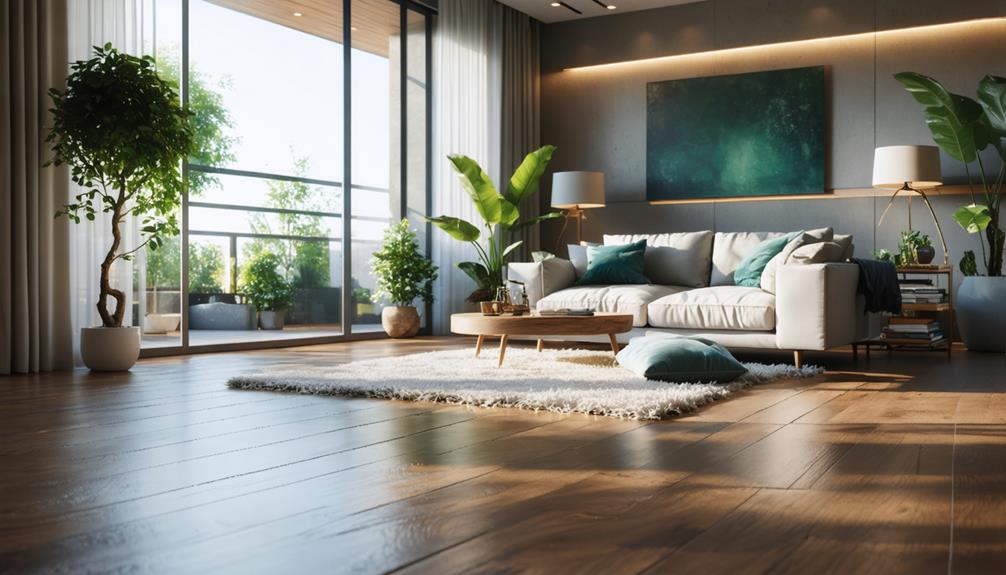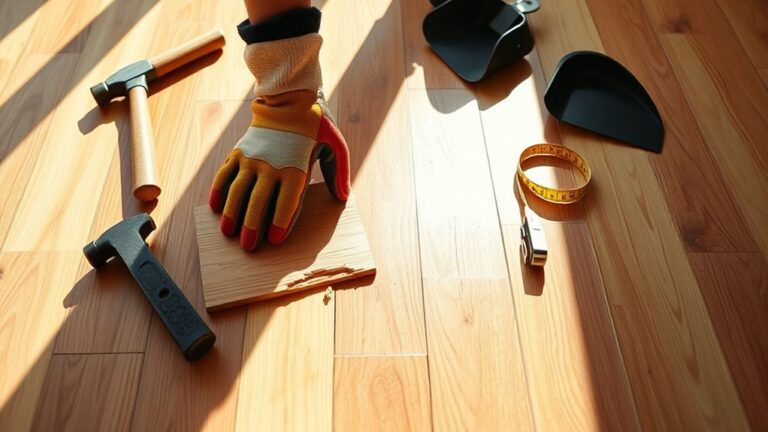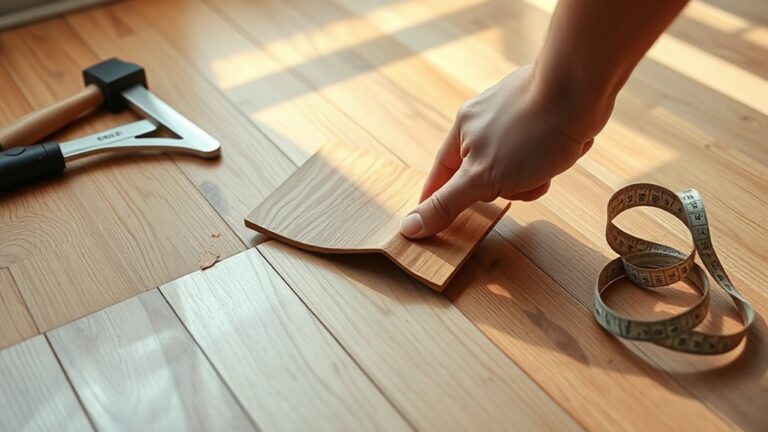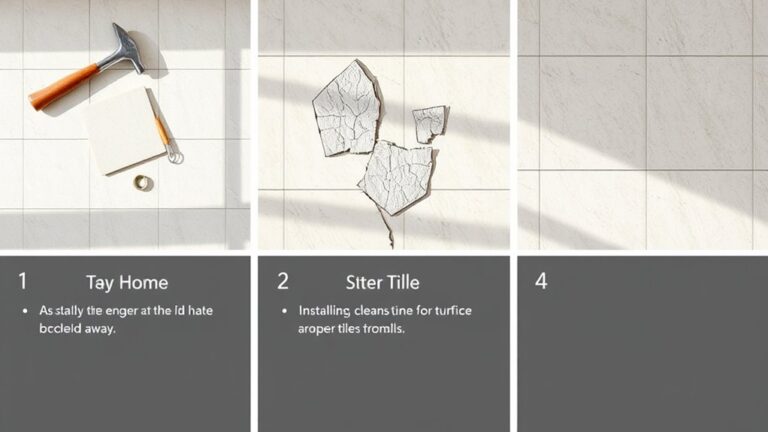When considering waterproofing solutions for hardwood floors, you'll want to focus on engineered hardwood with a waterproof core. This material combines real wood veneers with synthetic materials, providing increased durability and moisture resistance. Specialized finishes, like quality polyurethane sealants, help protect against spills and humidity. Ideal for areas prone to water exposure, these solutions require proper installation, including moisture barriers beneath the subfloor. Maintenance is vital—schedule periodic resealing and clean spills immediately to maintain integrity. Understanding your options will guarantee you choose the best solution for your home. There's much more to explore on this topic.
Understanding Waterproof Hardwood Flooring
Have you ever wondered how waterproof hardwood flooring differs from traditional options? The key lies in its advanced construction and moisture resistance technology. Unlike traditional hardwood, which is porous and vulnerable to water damage, waterproof hardwood flooring incorporates a multi-layer design that includes a waterproof core. This construction enhances stability, making it perfect for high-moisture areas like bathrooms and kitchens.
Engineered hardwood is a popular choice within the waterproof flooring category. It combines real wood veneers with synthetic materials, offering both aesthetic appeal and remarkable durability against water exposure. This means you can enjoy the beauty of wood without the constant worry of water damage, which is a common concern with traditional hardwood.
The waterproofing process for these floors involves specialized manufacturing techniques. Unlike DIY sealing methods that only provide surface protection, this process guarantees thorough waterproofing throughout the material. This technical approach not only prevents moisture absorption but also extends the lifespan of the flooring.
However, it is essential to recognize that while waterproof hardwood flooring offers significant benefits in moisture resistance and maintenance, it generally comes at a higher price compared to traditional hardwood options. This investment can be worthwhile, especially if you're looking for a durable and aesthetically pleasing solution for moisture-prone areas in your home. Essentially, understanding the differences between these flooring types can empower you to make a more informed choice that aligns with your lifestyle.
Benefits of Waterproof Flooring
When considering waterproof flooring, you'll find that it offers enhanced durability and longevity, making it a practical choice for high-moisture areas. Its aesthetic versatility means you can choose from a wide range of styles and finishes, ensuring it complements your home's design. This combination of functionality and visual appeal not only elevates your space but also adds value to your property.
Enhanced Durability and Longevity
Waterproof flooring consistently enhances the durability and longevity of hardwood by effectively combating moisture-related issues. By preventing moisture damage—such as swelling, warping, and buckling—these floors maintain their structural integrity far longer than traditional hardwood options. The durable, water-resistant coatings used on waterproof hardwood also resist scratches and dents, ensuring your flooring stays visually appealing through years of use.
Consider the following benefits:
- Increased lifespan: Enjoy a longer-lasting floor that withstands daily wear and tear.
- Easier maintenance: Quickly wipe away spills without worrying about permanent damage.
- Healthier environment: Reduced risk of mold and mildew promotes better indoor air quality.
- Higher home value: An investment in waterproof hardwood can enhance your property's overall worth.
With waterproof options, you're not just choosing a floor; you're opting for enhanced durability that allows you to live freely without the constant worry of moisture damage. This freedom to maintain your space while enjoying lasting beauty makes waterproof flooring a smart investment for any homeowner.
Aesthetic Versatility and Appeal
Aesthetic versatility is a hallmark of modern flooring solutions, and waterproof options exemplify this trait by offering a wide range of styles, colors, and textures to suit any design vision. You'll discover that waterproof hardwood floors cater to your aesthetic preferences while ensuring functionality. With a real wood top layer, these floors preserve the natural beauty of hardwood, delivering an authentic appearance that often surpasses synthetic alternatives.
In addition to visual appeal, many waterproof flooring products incorporate cushioned underlayment. This feature enhances comfort underfoot and contributes to a quieter ambiance in your living spaces. Unlike traditional hardwood, waterproof varieties resist swelling, warping, and buckling in moisture-prone areas, maintaining their integrity and appearance over time.
Choosing waterproof hardwood floors not only aligns with your design goals but can also increase a home's value. Their combination of durability and aesthetic appeal makes them an attractive option for potential buyers. With such versatility, you're free to create the ideal environment in your home, knowing that style and practicality coexist seamlessly. Embrace the freedom to choose a flooring solution that truly reflects your vision while standing the test of time.
Limitations of Waterproof Solutions
While waterproofing solutions for hardwood floors can enhance water resistance, there are several limitations you need to take into account. The costs associated with high-quality materials and professional installation can be significant, and many DIY methods only offer surface-level protection. Additionally, maintenance can be more complex, as certain waterproof finishes may require special care to prevent discoloration and damage over time.
Cost Considerations
When considering waterproofing solutions for hardwood floors, it's vital to evaluate the associated costs, which often exceed those of traditional hardwood options. The average price for waterproof hardwood flooring can surpass $8 per square foot, mainly due to the advanced materials and manufacturing processes involved. Installation can also be complex, typically requiring professional assistance, which further inflates your budget.
Additionally, you should be aware of potential future expenses:
- Higher maintenance costs if waterproof coatings discolor or fade
- Inability to refinish flooring without removing the waterproof finish
- Environmental concerns tied to synthetic materials used in production
- Long-term implications of a resource-intensive manufacturing process
These cost considerations can greatly impact your decision. While waterproof hardwood flooring offers durability, the financial commitment may not align with your desire for flexibility and freedom. Consequently, it's important to weigh the initial investment against potential long-term costs, including installation and maintenance. Ultimately, understanding these aspects will help you make an informed decision that best suits your lifestyle and budget.
Installation Challenges
Choosing waterproof hardwood flooring involves not just financial considerations but also significant installation challenges. Confirming the proper acclimation and subfloor preparation is critical to prevent potential water damage. Most homeowners find this process complex, often necessitating professional assistance.
To successfully install waterproof flooring, a moisture barrier underlayment is crucial. This not only protects against moisture but also provides sound insulation and enhances comfort underfoot. However, adhering to manufacturers' instructions is essential to maintain warranties and guarantee peak performance.
| Challenge | Impact on Installation | Solutions |
|---|---|---|
| Improper Acclimation | Warping/Damage | Allow wood to adjust to environment |
| Inadequate Subfloor Prep | Moisture Issues | Confirm a clean, dry, level surface |
| DIY Limitations | Quality Compromise | Hire professionals for installation |
| Discoloration of Coating | Aesthetic Concerns | Choose high-quality finishes |
As you weigh your options, keep in mind that the intricate nature of waterproof flooring installation requires careful planning and expertise. Balancing these installation challenges with your desire for freedom in home design can lead to a rewarding outcome when done correctly.
Maintenance Limitations
Maintaining waterproof hardwood flooring can present several limitations that homeowners should be aware of. While these floors offer water-resistant properties, they aren't completely impervious to moisture. The edges and undersides remain vulnerable, which might lead to potential issues over time. Additionally, refinishing your waterproof hardwood isn't straightforward; removing the waterproof coating is necessary, restricting your maintenance options.
Here are some key limitations you should consider:
- Higher Costs: Waterproof hardwood tends to be pricier due to advanced materials.
- Discoloration Risks: Over time, fading or discoloration of the waterproof coating can occur.
- Environmental Impact: The production of some waterproof options can be resource-intensive and synthetic.
- Quality Products Matter: Not all waterproof coatings provide the same level of protection, making product choice critical.
Understanding these limitations is essential for making informed decisions about your flooring. Choosing high-quality, water-resistant hardwood can minimize some issues, but it's crucial to remain vigilant about maintenance to preserve the beauty and functionality of your investment.
Ideal Locations for Installation
Finding the right spots for waterproof hardwood flooring can make a significant difference in maintaining the integrity of your home. When you think about high-moisture areas, the bathroom immediately comes to mind. Daily exposure to water in this space makes it essential to install waterproof hardwood flooring to withstand the inevitable splashes and spills.
Entryways and mudrooms also rank among the ideal locations for waterproof hardwood. These areas frequently encounter wet conditions due to shoes and outdoor gear, and using water-resistant wood here can help prevent potential damage. Similarly, kitchens are notorious for spills, making waterproof options a smart choice for peace of mind against water damage.
Utility and laundry rooms must not be overlooked. These spaces often experience soaking from washing machines and other appliances, so waterproof hardwood flooring is imperative to avoid moisture-related issues in the long run. If you're considering your basement, it's essential to prioritize waterproof hardwood flooring, especially in regions that may be prone to flooding or dampness. Here, the right flooring can protect against extensive water damage and maintain a dry, inviting environment.
Installation Preparation Steps
Before you start installing your waterproof hardwood floors, clear the room of all furniture and debris to create a clean workspace. Next, make certain your subfloor is dry, level, and free of any moisture-related damage, as this is essential for effective waterproofing. Taking these initial steps will set the stage for a successful installation process.
Room Clearing Process
To guarantee a smooth and effective waterproofing process for your hardwood floors, you'll need to start by thoroughly clearing the room of all furniture and items. An unobstructed workspace is essential for applying waterproofing products correctly and effectively. Follow these steps to make certain everything is ready:
- Remove all furniture: This prevents damage and allows easy access to every corner.
- Take down rugs and curtains: Protect them from potential stains or contamination.
- Clean the floor thoroughly: Dirt, dust, and debris can hinder the adherence of waterproofing treatments, so make sure to clean the floor meticulously.
- Inspect existing floors: Look for scratches or gouges that need repair before applying any products.
Don't forget about ventilation! Ensure proper airflow by opening windows or using fans. This facilitates drying and enhances air circulation during the waterproofing process. By following this room clearing process, you'll set the stage for a successful waterproofing application, making certain your hardwood floors remain beautiful and protected for years to come.
Subfloor Preparation Techniques
Once the room has been cleared and prepared, attention turns to the subfloor, which plays an essential role in the overall integrity of your hardwood flooring installation. First, verify the subfloor is clean, dry, and level. Any imperfections can lead to issues with the flooring above, so take the time to fill in gaps or level uneven areas.
Next, it's critical to incorporate a moisture barrier underlayment. This step is necessary for protecting your hardwood from moisture seeping up from the subfloor, especially in damp environments. In basement installations, sealing the cement slab with waterproof concrete sealers can prevent moisture from wicking into the hardwood, securing longevity and performance.
Don't forget to follow the manufacturer guidelines for subfloor preparation. Adhering to these recommendations will help maintain warranty compliance and optimize the performance of your flooring. By investing time in thorough subfloor preparation, you're setting the stage for a durable, water-resistant hardwood floor that's built to last. Remember, a solid foundation is key to achieving the beautiful finish you desire.
Enhancing Existing Hardwood Floors
While enhancing existing hardwood floors, it's important to realize that applying 2-3 coats of high-quality polyurethane can greatly boost their water resistance. This method doesn't fully waterproof your floors but greatly improves their ability to withstand moisture. Before you apply any waterproofing treatment, make sure to address any existing damage to the hardwood. This step is essential to guarantee that your efforts aren't compromised by underlying issues.
Consider the benefits of enhancing your hardwood floors:
- Increased durability: Enhanced water resistance means your floors can better handle spills and humidity.
- Longer lifespan: Proper treatment and maintenance can extend the life of your existing hardwood.
- Improved appearance: A fresh coat of polyurethane can revive the natural beauty of your floors.
- Peace of mind: Knowing your floors are better protected allows you to enjoy your space freely.
Regular maintenance, such as quick cleanup of spills, is vital. Even with enhanced water resistance, standing water can penetrate exposed plank edges, leading to potential damage. If you have pre-finished solid hardwoods, you're already benefiting from factory-applied finishes that offer inherent water resistance, particularly in moisture-prone areas.
It's important to understand that DIY sealing methods typically provide only surface protection. They leave the edges and undersides vulnerable to moisture infiltration. As a result, a more thorough approach is necessary if you want your existing hardwood to withstand the test of time.
Maintenance Tips for Longevity
Maintaining the longevity of hardwood floors, especially those enhanced for water resistance, requires a proactive approach. One of the key maintenance tips involves immediately cleaning spills to prevent moisture penetration. Standing water can seep through gaps and edges, leading to moisture damage that compromises your floors.
To further protect your investment, apply at least 2-3 coats of a quality waterproof sealant. This not only enhances water resistance but also safeguards against potential damage, particularly in moisture-prone areas such as kitchens and bathrooms. Regularly scheduled periodic resealing is vital; it helps maintain the waterproof finish and greatly extends the lifespan of your hardwood floors.
Additionally, make certain that areas with higher humidity are properly ventilated. This reduces moisture buildup, which, if left unchecked, can lead to mold and mildew growth. Conducting routine inspections for signs of wear or damage is essential. Look for scratches, dents, or any noticeable changes in the finish, as prompt repairs can prevent further degradation and maintain the integrity of your waterproofed hardwood floors.
Product Options for Waterproof Flooring
When selecting waterproof flooring options, it's essential to evaluate materials that can withstand moisture without compromising aesthetics or structural integrity. You want to make sure your choice not only looks good but also endures the challenges of moisture-prone areas. Here are some top options that fit the bill:
- Engineered hardwood floors: Featuring a waterproof core and a protective finish, these floors resist water infiltration, making them a smart choice for kitchens and entryways.
- Luxury Vinyl Plank (LVP): Specifically designed to combat water exposure, LVP is perfect for basements and bathrooms, offering durability without sacrificing style.
- Solid white oak: With multiple UV-cured polyurethane coats, these floors boast impressive surface water resistance, making them suitable for high-moisture spaces.
- Ceramic tile: Known for its natural water resistance, ceramic tile is often used in bathrooms and kitchens due to its impermeable surface.
To enhance the longevity of your waterproof floors, consider applying polyurethane sealants to existing hardwood. Regular maintenance and resealing can notably extend their lifespan in moisture-prone areas, allowing you to enjoy beautiful flooring for years to come. Choosing the right product is essential to ensuring that your flooring not only meets your aesthetic needs but also stands up to the inevitable wear and tear of a moist environment.
Customer Support and Resources
Easiklip Floors prioritizes customer satisfaction through extensive support and valuable resources. When you're looking to make hardwood waterproof, having reliable customer support is essential. Easiklip offers accessible contact information, making it easy for you to reach out with any inquiries or assistance you might need regarding their products. Whether you have questions about the existing waterproofing solutions or need guidance on which products you can buy, their team is ready to help.
To further enhance your experience, Easiklip provides a 30-day money-back guarantee. This means if you're not satisfied with your purchase, you can return it within that timeframe, ensuring peace of mind as you explore ways to protect your investment from moisture. Additionally, their warranty options cover manufacturing defects, adding an extra layer of confidence in your purchase.
For those who frequently buy products, Easiklip's pro rewards program offers incentives and discounts, making it easier to stock up on the flooring solutions you need. By subscribing to the company's newsletter, you'll stay informed about promotions, coupons, and new product launches, keeping you in the loop about the latest advancements in waterproofing technology for hardwood floors.
Easiklip's commitment to customer support and resources empowers you to make informed decisions, ensuring you can effectively protect your hardwood floors from moisture while enjoying the freedom of beautiful, durable surfaces.
Comparing Waterproof and Water-Resistant Floors
Choosing the right flooring for your home involves understanding the key differences between waterproof and water-resistant options. Waterproof wood is engineered to repel water indefinitely, making it ideal for high-moisture areas like bathrooms and basements. On the other hand, water-resistant finishes, such as varnish or lacquer, only provide temporary protection, allowing limited cleanup time before damage can occur.
Here's what you should consider when comparing these flooring types:
- Permanent Protection: Waterproof hardwood requires sealing around the boards to guarantee extensive moisture resistance.
- Surface-Level Defense: Water-resistant finishes offer only surface protection, which may not hold up against significant spills.
- Best for Humidity: Engineered hardwood typically features waterproof coatings and multi-layer constructions, making it suitable for high-humidity environments.
- Placement Matters: Water-resistant flooring is best for low-moisture areas, like powder rooms, where the risk of water exposure is minimal.
Understanding these differences is essential. If your lifestyle includes frequent exposure to moisture, waterproof wood could provide the freedom and peace of mind you desire. However, if you're looking to enhance a low-moisture space, water-resistant finishes may suffice. Ultimately, knowing your environment will guide your choice and guarantee your flooring decision aligns with your needs, balancing durability and aesthetic appeal.
Frequently Asked Questions
How Do I Waterproof My Hardwood Floors?
To waterproof your hardwood floors effectively, start with proper installation techniques, ensuring the seams are tight to create moisture barriers. Apply water resistant finishes, like polyurethane sealants, in 2-3 coats for ideal protection. Before applying, prep the surface by cleaning and sanding for a better bond. Regular floor maintenance is key; clean spills immediately and consider periodic resealing to prolong your wood treatment. This approach will help keep your floors looking great and lasting longer.
What Is the Best Sealant for Hardwood Floors?
When choosing a sealant for hardwood floors, consider sealant types like oil-based and water-based polyurethanes. Oil-based offers superior durability but can be costlier, while water-based dries faster and has less odor. For application techniques, sanding the surface enhances adhesion. A durability comparison shows oil-based performs better in high-traffic areas. Regular maintenance, including reapplying every few years, is essential. Weighing cost analysis against long-term benefits can guide your choice effectively.
How to Make a Wooden Bathroom Floor Waterproof?
To transform your wooden bathroom floor into a fortress against moisture, start with meticulous bathroom wood treatments. Apply waterproof floor finishes, ideally 2-3 coats of high-quality polyurethane, ensuring a resilient shield. Don't forget moisture barrier installation beneath the flooring to block humidity's relentless advance. Regular wood floor maintenance, including prompt spill cleanup and resealing, is essential to keep your floor thriving. Embrace humidity control methods to protect your wood and enjoy a lasting, beautiful space.
What Pulls Moisture Out of Wood Floors?
To pull moisture out of wood floors, you'll want to focus on effective humidity control and flooring maintenance. Dehumidifiers can greatly reduce moisture absorption by lowering humidity levels in the air. Utilizing drying techniques, like proper ventilation and silica gel packets, actively removes moisture. Regular cleaning helps prevent spills from seeping into the wood. Combining these methods not only aids in wood preservation but also maintains the integrity of your flooring for years.




